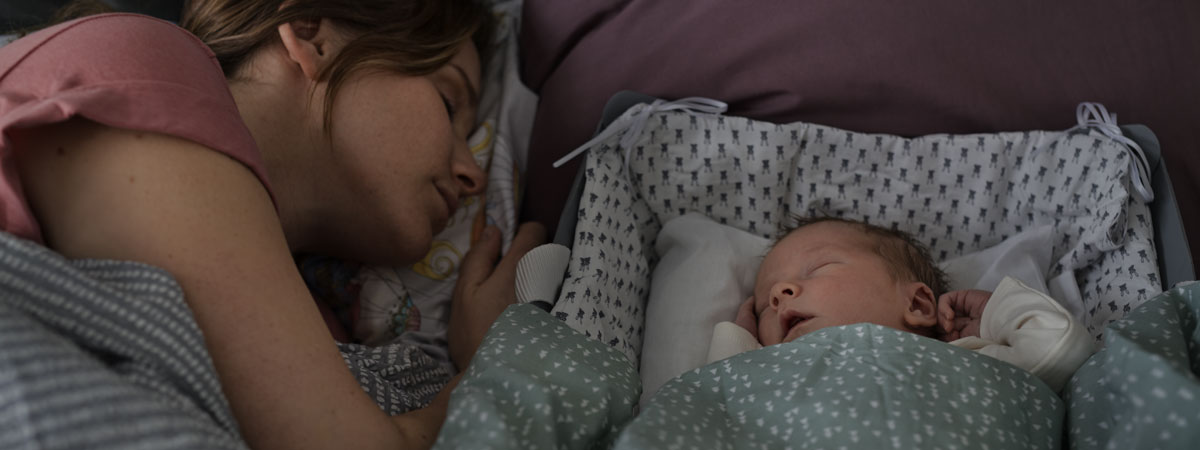Safe co-sleeping
The sound of small, soft breaths – sleeping with your baby may be cosy, but there are some important things to consider when it comes to safe co-sleeping. If you want to sleep with your baby in your bed, you need to ensure that your little one has their own safe place to sleep.
A newborn baby’s sleep is something that many parents focus on. Perhaps you have heard stories of children who sleep through the night, and you hope that your own little angel will do the same. But a small child who has not yet gotten used to the big wide world usually wakes up at regular intervals to make sure someone is there – our little ones need physical closeness, touching and body contact. For young infants, this need is largely met through breastfeeding or bottle feeding, as most babies need to eat during the night until they are about six months old – for purely nutritional reasons. And these many nightly awakenings mean that it is not uncommon for parents to want to co-sleep with their baby.
Co-sleeping with your baby
Whether it is a good idea for parents to sleep in the same bed as their little baby is a matter of debate. The physical closeness this entails is important, but of course it must be ensured that the baby is not at risk of being crushed by a large adult body during the night. In Sweden, for example, the authorities currently recommend that babies should sleep in their own bed until they are at least three months old, to reduce the risk of sudden infant death syndrome (SIDS). But if, despite whatever recommendations may apply in your country, you still feel that you want to have your baby in the same bed, so that you can comfort or feed your child when he or she wakes up, the single most important thing is to ensure that you provide the child with their own safe place to sleep next to you. A good solution is for the child to have their own baby nest or pod in the bed, or to arrange a similar enclosure with sides so that the baby is protected from large bodies, heavy blankets, stuffed animals or any pets that may end up over the baby’s face. Another convenient solution is to have a bedside crib – a cot with an open side facing towards your bed.
Eight tips on safe co-sleeping
Here are some important things to consider when sleeping together with your baby:
- Until they are six months old, or able to turn over on their own, babies must always sleep on their back.
- Babies must not sleep on their side.
- Babies should have their own safe place to sleep in the bed, with sides (make sure that the bed is wide enough to enable this).
- The mattress must be firm so that the baby does not sink down. A waterbed is not suitable for co-sleeping with a baby.
- The bed must not get too hot – make sure that the baby wears pyjamas instead of piling on blankets.
- Make sure that there is no risk of the baby’s head ending up under your pillow or quilt.
- Make sure that there is no risk of the baby rolling or falling out of the bed, or getting trapped or squashed.
- If you are sick, on medication or under the influence of drugs or alcohol, you must never co-sleep with an infant.
Is it dangerous to sleep with your baby on your chest?
It’s a familiar scene – that little nap after your baby has eaten, when you lean back on the sofa and let your little one sleep on your chest. But is it safe to do so? As long as you are awake, it is okay – although babies should not lie on their stomach while sleeping, an exception can be made in this instance as long as you are there to listen to your baby’s little breaths, so that you can hear if something happens or feel if your baby starts to slide to the side. But don’t underestimate how relaxing it can be to have a little baby on your chest – it’s easy to fall asleep in this situation, and if you’re sitting upright, the baby may fall down before you wake up.
How long can parents co-sleep with their children?
As babies get older, the risk of sudden infant death syndrome decreases. As previously mentioned, the authorities in Sweden recommend that babies should have their own place to sleep until they are three months old, but a three-month-old little bundle of joy is still a very small child, so the best advice is to let a baby have its own place to sleep until the baby is able to turn over by itself in its sleep. The question of how long you can then co-sleep with your child, and when you must stop, is entirely up to you as a family. Ensuring that all members of the family – including the adults – get a good night’s sleep is more important than you might realise. For some families, the best solution is co-sleeping for a number of years, while for others, it is better if everyone sleeps in their own bed in their own room.
Please note that all information above is based on Swedish recommendations.

